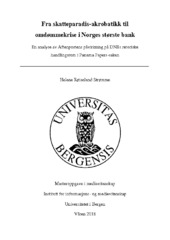Fra skatteparadis-akrobatikk til omdømmekrise i Norges største bank: En analyse av Aftenpostens påvirkning på DNBs retoriske handlingsrom i Panama Papers-saken
Master thesis
Permanent lenke
http://hdl.handle.net/1956/18273Utgivelsesdato
2018-07-03Metadata
Vis full innførselSamlinger
Sammendrag
Innenfor krisekommunikasjonsforskning er det stor enighet om at mediene spiller en sentral rolle i kriser og at organisasjoners krisekommunikasjon foregår i et samspill med mediene. Konkret hvordan dette samspillet foregår er imidlertid et understudert fenomen. Dette søker studien å gjøre noe med og tar derfor for seg ett aspekt ved dette fenomenet – nemlig hvordan et nyhetsmedium gjennom sin innramming av ansvar påvirker en organisasjons retoriske handlingsrom i en krise. Dette belyses ved å foreta en casestudie av krisen Norges største bank, DNB, opplevde da avisen Aftenposten i april 2016 avslørte at banken gjennom sitt kontor i Luxembourg hadde tilrettelagt for at kunder kunne plassere penger i lavskattlandet Seychellene. Avsløringen var et resultat av et journalistisk graveprosjekt kalt Panama Papers, som omtales som tidenes største dokumentlekkasje. Studien finner at Aftenposten gjennom sin innramming av ansvar ikke bare legger konkrete føringer for hva som utgjør en passende respons i den retoriske situasjonen, men også påvirker hvordan DNB velger å agere. Studien kombinerer ulike teoretiske perspektiver innenfor medievitenskap, retorikk og krisekommunikasjon og benytter Lloyd F. Bitzers begrep den retoriske situasjon og W. Timothy Coombs’ Situational Crisis Communication Theory som analytisk rammeverk. In the field of crisis communication, it is widely agreed that the news media play a central role in a crisis, and that there is a dynamic interaction between the news media and an organization’s crisis communication. However, there is little literature studying this interaction. Therefore, this study seeks to dive into one aspect of this phenomenon and examines how the news media’s use of the attribution of responsibly frame affects an organization’s rhetorical actions in a crisis. This is done by conducting a case study of the crisis DNB, Norway’s largest financial institution, experienced when the Norwegian news paper Aftenposten exposed how DNB Luxembourg, a subsidiary to DNB, had helped their customers to hide their money in the low-tax country Seychelles. The revelation was a result of a journalistic project called Panama Papers, which is referred to as the biggest document leakage of time. This study finds that Aftenposten, through its use of the attribution of responsibility frame, not only sets guidelines for what constitutes a fitting response in the rhetorical situation, but also affects how DNB acts. The thesis combines theoretical perspectives from media studies, rhetoric and crisis communication, and uses Lloyd F. Bitzer’s concept of the rhetorical situation and W. Timothy Coombs’ Situational Crisis Communication Theory as analytical framework.
